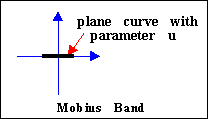
Some of John's sculptures have a precise mathematical description:
this is so for example for ETERNITY ,
GORDIAN KNOT,
DEPENDENT BEINGS,
MUSIC OF THE SPHERES,
RHYTHM OF LIFE. All of these may be described
as `fibre bundles', with base a circle, and a 2-dimensional shape,
called the fibre, which is slotted onto the circle and twists as it
moves around. The fibre bundle needs for its description the base, fibre,
and the amount of twist. Amazingly, this mathematical description corresponds
precisely to how the first four of these were made!
Our pictures were made in three stages, using the following packages, all under UNIX:
Note that one of the aims was to produce a finished product in a limited amount of time and without a steep learning curve for us, and also so that the result could be viewed on a range of browsers. At a later stage, other methods and facilities could be used as the internet facilities develop.
For example, the sequence of 60 .gif files to produce the smoothly rotating Mobius band took about an hour to produce from the read in .mesh file in GEOMVIEW.
Now we explain more about the initial stages, particularly for those with more mathematics.
For us, the advantages of AXIOM as a symbolic computation package were:
(i) all mathematical and datatype code is open, and so can be modified and adapted for new purposes,
(ii) the strongly typed language, with parametric datatypes, inheritance, and coercion, makes it appropriate for dealing with mathematical structures, i.e. for dealing with mathematics,
(iii) it was available, due to an EPSRC grant to R. Brown and T. Porter for work in `Non abelian homological algebra',
(iv) the already written code in ntube.inputs and in the export to GEOMVIEW files of Larry Lambe were exactly suitable for the purpose in hand.
This file allows the specification of a base 3-dimensional curve, called here the space curve; in all the five examples here, the space curve is a circle, given by the formula (4*cos(t), 4*sin(t),0), for a range of values of t. Next one specifies a 2-dimensional curve, giving the shape of the `fibre'. There are several ways of specifying this for the given results, for example by specifying the fibre as a square, triangle, and so on. We are able to specify a twisting function, which rotates the plane curve by some function depending on t as the plane curve moves along the space curve. Because of this twisting, it was possible to specify the plane curve in a simpler fashion, as only a part of the fibre, but allowing a multiple traverse of the space curve.
A final point of information is the number of steps for each of the u and t variables. The payoff here is that a small number of steps leads to a quickly executing program, but the result can be jagged. The effect is often interesting, but not what was intended as a model of the sculpture. A small amount of jaggedness will be smoothed satisfactorily in the GEOMVIEW program.

The space curve is a circle, radius 4, traversed for t from
0 to 2pi. The plane curve is the line segment on the x-axis
from -1 to 1. The twisting is by t/2.
(We have a moving picture of this)
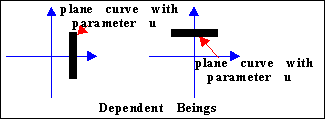 This is made of two Mobius bands put
together, rather than a twisting square, since this is simpler to code and
also allows the two bands to be of different colour, as in the sculpture.
This is made of two Mobius bands put
together, rather than a twisting square, since this is simpler to code and
also allows the two bands to be of different colour, as in the sculpture.
(We have a rotating picture of this)
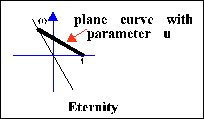
The plane curve is given in complex number notation by (1-u) + uw, where 0 <= u <=1, and w is the complex cube root of 1. (Here `<=' means `less than or equal to'. ) The range of t is from 0 to 6pi, and the twist is by t/3.
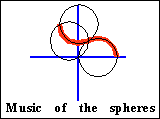
The base circle is of radius 4, traversed 3 times. The plane curve is given by [1+ cos u,sin u] if 0<= u and u <2*%pi/3 and [cos(-u +%pi/3),sin(-u+%pi/3) +sqrt(3)] for 2*%pi/3 <= u and u <= 4*%pi/3. The twisting is by t/3.
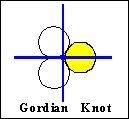
The base circle is of radius 5, traversed 3 times. The plane curve is the circle [2/(sqrt{3}) + cos u , sin u] centre (2/(sqrt(3),0) and radius 1, and the twist is by 8t/3. (There is full scale rotating picture of this).
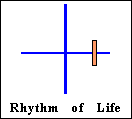
The base circle is of radius 2, traversed 4 times. The plane curve is a rectangle centre (1,0) and of sides 0.4 and 0.1. The twisting is by 15t. (We have a slowly rotating picture of this).
This is obtained by creating two toruses in 3-space, using the draw function, with a tube around the curve. The radius of each tube is 0.5, and one of them is given by the curve (sin(t),cos(t),0) and the other by the curve (0,1+sin(t), cos(t)). (There is a 3D rotating version of this on the title page of this site).
Here it was necessary to take the space curve to be a trefoil knot, and the plane curve to be a rectangle. We found it difficult to model the sculpture exactly, since the trefoil curve as used by John was not described by the simple mathematical formulae we tried. Also, the twisting of the curve was unduly reflected in the twisting of the rectangle, and so again the formulae we used does not give an exact model. To do so, a lot more experimentation would be needed. (We have a rotating picture of our attempt!).
The interesting point is that so many beautiful objects which stir the imagination are described by simple exact formulae, rather than that one sculpture is only inexactly described by the formulae we used.